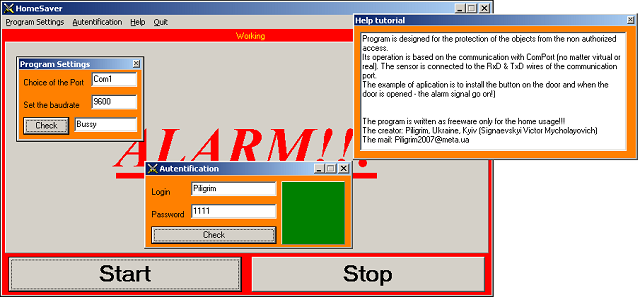Homemade Alarm System

Introduction
This article describes a security software system. Suppose you have no skills or soldering equipment, but you want to provide security for the apartments. We just mount button to the door and connect it directly to the COM port of the PC (2nd and 3rd pins).

We start the program and press the “Start” button. In case the door is opened, speakers will provide a siren sound. The project is written as some kind of “toy software”.
Background
Once as a student living in a hostel, the door lock suddenly failed. Since at that time I stayed alone in the room, I'd have to sleep with the “open” door. At this point, I got the idea to make an open door alarm tool. All I had was a piece of wire and a computer...
Using the Code
The project is written using “Borland C++ Builder 6”. The main idea of this project is in fact that if we are transmitting signals through the COM port TX line to the RX line of the same port, it is possible to catch the transmitted data. So, if contact is broken (button is unpressed, door is opened), data wouldn’t come back.
The algorithm of the program is as follows:
- Open COM port.
- Send byte of data to the TX line.
- Try to receive data from the RX line.
- Check the received data. If received data differs from the transmitted – turn on siren sound.
void __fastcall TFormMain::ButtonStartClick(TObject *Sender)
{
FormMain->LabelStatus->Caption="Working";
FormMain->TimerMain->Enabled=true;
ComPort_PurgeCom();
ComPort_PutByte(0xff);
if(ComPort_GetByte(1))
{
FormMain->PanelMain->Caption="All right!";
FormMain->Color=0x000080FF;
}
else
{
FormMain->PanelMain->Caption="ALARM!!!";
//ALARM!!!
DWORD fdwSound = SND_ASYNC | SND_FILENAME;
PlaySound("sounds/ALARM.wav",NULL, fdwSound);
FormMain->Color=clRed;
}
}
To avoid unauthorized access to the software, I’ve made an authorization routine.
void __fastcall TFormAutentification::ButtonCheckClick(TObject *Sender)
{
AnsiString login="Piligrim";
AnsiString password="1111";
if(login==EditLogin->Text)
{
if(password==EditPassword->Text)
{
FormAutentification->PanelStatus->Color=clGreen;
Access();
}
else
{
FormAutentification->PanelStatus->Color=clRed;Decline();
}
}
else
{
FormAutentification->PanelStatus->Color=clRed;
Decline();
}
FormAutentification->TimerMain->Enabled=true;
}
The default login: Piligrim
The default password: 1111
Since COM port number and the baud rate are changeable values, it was necessary to provide an additional form where the obvious values could (and should) be put on.
void __fastcall TFormSettings::ButtonCheckClick(TObject *Sender)
{
//checking of the edits "emptiness"
if(EditCom->Text.IsEmpty())
{
EditCom->Text="Com1";
}
if(EditBaud->Text.IsEmpty())
{
EditBaud->Text="9600";
}
//to close the port
ComPort_Close();
//entering the number of the comport
AnsiString ComPort=EditCom->Text;
char *ComP = ComPort.c_str();
//entering the baudrate of the comport
AnsiString BaudRate=EditBaud->Text;
unsigned long Baud = BaudRate.ToDouble();
BOOL bOpened;
ComPort_PresetParameters(Baud,8,NOPARITY,ONESTOPBIT);// optional function
bOpened = ComPort_Open(ComP);
if(bOpened!=0)
{
EditStatus->Text="Ready";
//wellcome note
DWORD fdwSound = SND_ASYNC | SND_FILENAME;
PlaySound("sounds/wellcome.wav",NULL, fdwSound);
FormSettings->Close();
}
else
{
EditStatus->Text="Bussy";
//error note
DWORD fdwSound = SND_ASYNC | SND_FILENAME;
PlaySound("sounds/error.wav",NULL, fdwSound);
}
}
As we can see from the code, in case the chosen COM port is ready, the “welcome” sound rises, otherwise the “error” sound appears. To get the list of accessible COM ports in your PC, just type “mode” command in the “cmd.exe” shell. You will get something like:

Points of Interest
Now we see that it is quite easy to provide a security device like that. Usage of the sound effects is pretty good, but it is not enough. A more interesting thing would be to create a report to the web server (for instance, it could be a mail report). But that will be done in a future article and it seems to me that using C# programming language would be more convenient for such kind of tasks.
History
- 18th May, 2011: Initial version
发表评论
QEx9QA My brother recommended I might like this web site. He used to be entirely right. This publish actually made my day. You cann't imagine simply how a lot time I had spent for this info! Thank you!
dV2Kub Say, you got a nice blog post. Want more.
DpiMsc Thank you for your blog post.Much thanks again. Will read on...
jKWhZ3 Thanks for the article.Much thanks again. Keep writing.
yNPGvv Great article.Really looking forward to read more. Keep writing.
BAtqAl Thanks again for the blog. Awesome.